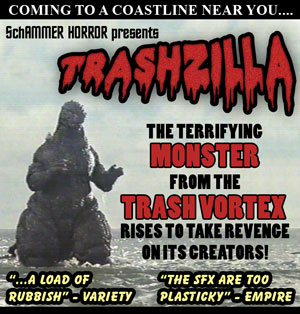
Home
| Friday 15th February
2008 | Issue 620
GARBAGE GAIAAS A HUMAN MADE MONSTER ENGULFS THE PACIFIC OCEAN... So where is the world’s biggest landfill? And we are talking really big here. In the US? China, maybe? Well it covers an area at least a quarter of a million square miles... nearly three times the size of the UK. Any ideas? OK, well it was a trick question really – it’s actually a slick of human debris in the sea, floating around in the Pacific starting from around 500 miles off the west coast of the US. It’s caused by rubbish that gets caught up by spiraling underwater ocean currents, called a gyre, which draw it in from all around and trap it into a floating layer of filth near the surface of the ocean. Named by a Star Trek fan no doubt, the phenomenon has not been named ‘Garbage Gyre’, but given the more frightening tag of ‘Trash Vortex’. Just how big it is a matter of hot debate. While many organisations cite it as being around the size of Texas, Charles Moore, the American oceanographer credited with first discovering it, has recently been quoted as claiming that it’s now twice the size as continental United States, extending nearly all the way to Japan. Either way, its staggeringly big. (Sadly as it's largely translucent, it’s not visible by satellite so no good rushing to download Google earth). Whilst some of the junk is stuff dumped by boats of one sort or another or off oil platforms, 80% of it originates from the land. It’s caused by wind and rain taking trash from the land (and indeed landfills) into rivers, people dumping along the coasts, poor sewage treatment and waste from industry. Just how many millions of tons a year the Konsumer Kings of Krap discard into their vortex may be unknown, but with Californians alone using 19 billion plastic bags a year, there’s no shortage of waste to go round. In fact around 90% of human pollution in the sea is plastic and this is far from fantastic news for sea-dwelling organisms and the ocean ecosystems. Made from a process using that ol’ war-causing fossil fuel, oil, plastic is toxic to marine life and indestructible. While most plastics only officially take up to hundreds of years to ‘degrade’, the truth is they never actually chemically break down and return to the ecosystem at all - they just disintegrate into ever smaller pieces, making a deadly plastic dust. And it doesn’t always have to wait so long to be dust; billions of tiny plastic pellets, called nurdles - the raw materials for the plastic industry - are lost or spilled every year, many ending up in the sea. These act like chemical sponges, soaking up other toxic man-made chemicals, all artificial pollutants (for toxicity think DDT pesticide etc), concentrating them up to a million times more than in normal sea water. Plastic is therefore a catastrophic threat to the world’s seas as stuff chucked away anytime in the last fifty years is still out there degrading somewhere. Waste caught up in the trash vortex, the gyre currents keeping it suspended in a plastic ‘soup’ near to the surface, is only the thin end of the widget. Around 70% of marine plastic waste sinks straight to the sea floor where it can slowly choke plant life and the animals that feed on it, unseen. According to the UN Environment Programme, plastic debris causes the deaths of more than a million seabirds every year, with countless fish and more than 100,000 whales, seals and turtles. Greenpeace have identified at least 267 separate species known to have suffered from entanglement or ingestion of marine debris. And before we get too cocky about how green and caring Europe is compared to their uncouth American cousins... they may not have vortices, but the North Sea is one of the most polluted seas in the world and the Mediterranean is the most plastic-polluted sea by density on the planet. Whether serious attempts to do anything about our constant adding to an already critical problem will really materialise before climate change or economic collapse give us a helping hand is anyone’s guess (you can guess what we’d guess) – and so much damage has already been done. With respected journal ‘Science’ projecting that Earth’s stocks of fish and seafood will collapse by 2048 if trends in overfishing and pollution continue, it looks like we’re all gonna be sea sick soon. For more see www.greenpeace.org/international/campaigns/oceans/pollution/trash-vortex
Subscribe to SchNEWS: Send 1st Class stamps (e.g. 10 for next 9 issues) or donations (payable to Justice?). Or £15 for a year's subscription, or the SchNEWS supporter's rate, £1 a week. Ask for "originals" if you plan to copy and distribute. SchNEWS is post-free to prisoners. |
|||
@nti copyright - information for action - copy and distribute! |
|||



